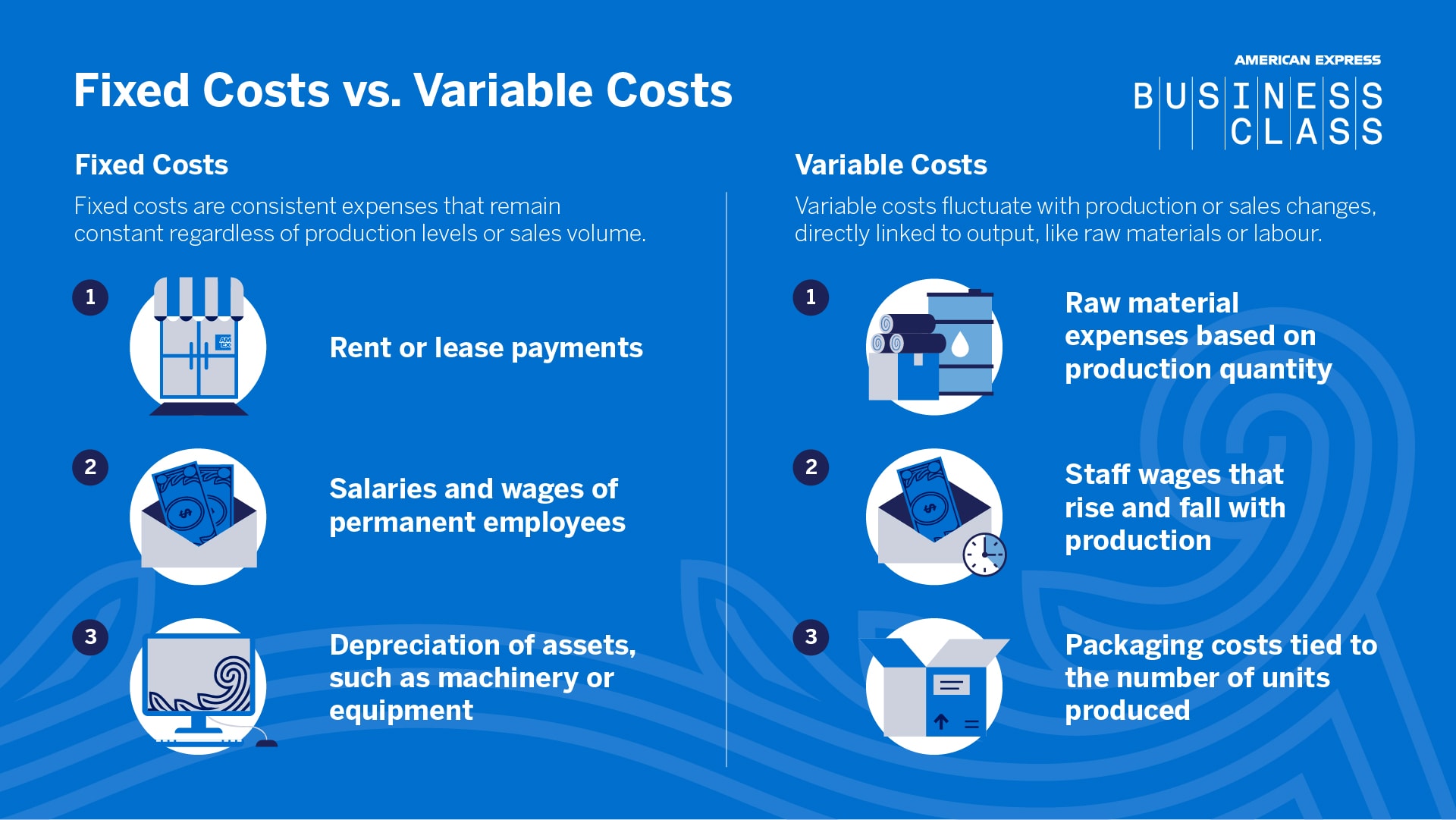What is a variable cost?
A variable cost is any business expense that is directly correlated to your company’s production or sales. As your sales increase, variable costs will increase. If sales or production fall, then those costs will also fall. The easiest way to determine if a cost is variable, therefore, is to work out if the cost changes in line with output.
Variable costs vs fixed costs
 |
Fixed costs are those costs that the business must pay regardless of how many products are made and sold. As Simon Laurie, a senior manager for outsourced business with accounting firm McBrides, puts it: "If your company makes pens, then you will have certain costs that are fixed, whether you’re making 50 pens or 50,000.”
These fixed costs would include the cost of the machinery to make the pens or factory rental costs.
In contrast, if the pen manufacturer scales up production, it could expect to spend more on raw materials and sub-contracted labour. These costs are known as variable costs. Knowing both fixed and variable costs is critical when calculating a company's break-even point.
Examples of variable costs
As discussed, examples of variable costs include things that are impacted by demand. This includes raw materials and packaging costs. Labour can be considered a variable cost when it is tied to the quantity of items produced. Overtime wages may also count as variable costs because this depends on demand. Further variable cost examples can include:
- Utility bills: Electricity, gas and water bills based on production levels or the extent of business operations.
- Shipping costs: Costs associated with the transportation of goods which increase with the quantity of products shipped.
- Commissions: Sales commissions paid to employees or external sales representatives are variable costs, as they are typically a percentage of sales. When more products are sold, the commission expenses increase.
- Direct product expenses: Some expenses, such as direct expenses related to a specific project or production run, are variable. For instance, expenses associated with a particular marketing campaign may vary based on the scale of the campaign.
The types of variable costs incurred by businesses will vary depending on the nature and industry of the business, explains Laurie. A professional services firm like a marketing agency, for example, could find its variable costs include professional fees and software licences.
Go Swag, a Glasgow-based business that supplies branded employee gifts, offers the option to custom-build gift bag contents and packaging. This results in hundreds of potential configurations of items, packages, and shipping destinations - and a high variability of costs every day.
The company's CEO Conor McKenna says its variable costs generally fall into three categories. The first is the physical expense of purchasing inventory which is subsequently branded and packaged. Next are shipping costs like fuel surcharges and border fees. Lastly, there's the marketing and sales expenditure “which will vary depending on the vertical we’re targeting, and the varied cost of acquisition and conversion”, says McKenna.
An unexpected spike in orders will drive up variable costs and could cause potential cash flow issues for your business if you receive payment on delivery of your goods or services. With an American Express® Business Gold Card, you get up to 54 days to clear your Card balance, so you can keep your money in the account for longer and get more flexibility in your cash flow¹.
How to calculate variable costs
In general, a company can calculate variable costs by multiplying the variable costs attributed to producing one unit of a particular product by the total number of products produced.
Variable cost formula
The variable cost formula is:
Variable Cost = Variable Cost Per Unit x Total Number of Units
For example, if a company manufactures Christmas trees, the variable costs might include:
- Raw materials
- Packaging
- Seasonal labour
- Packaging and distribution
Using the variable cost formula, the company could work out that it costs £45 to produce a single Christmas tree, including labour, materials, packaging and distribution. If the company produces 100,000 Christmas trees each year, then the total variable cost would be 100,000 x 45, or £4.5 million.
Understanding the variable cost formula is useful for companies like Go Swag because it helps with forecasting, says McKenna. “We can use our knowledge of variable costs to look at what happens if a supplier increases the cost of an item by 5%, or if the cost of shipping increases by 20% to a particular location,” he says. “We use Google Spreadsheets with custom calculators that constantly look at cost data to model what that means for our overall financial position.”
Laurie explains that the value in tracking variable costs is that it allows you to see your gross profit margin, and to protect that margin if variable costs change. “Businesses should be using variable costs to predict what happens to their gross profit margin if sales increase or fall by 20%, or if one of those costs increases dramatically,” he says.
Average variable cost formula
The average variable cost (AVC) is a way of measuring the total variable cost per unit sold. The formula for calculating average variable cost is:
AVC = Total Variable Cost / Total Output
Businesses can use average variable costs to understand if they’re making a profit on their activities. If the price charged to the customer is above the AVC, then the business is likely to make a profit. If the price falls below the AVC, then the firm is no longer covering variable or fixed costs, and the business should stop production and simply pay fixed costs.
Semi-variable cost formula
A semi-variable cost is one where the cost is partly fixed, and partly variable. This might happen where you pay a set fee or have a minimum order to access a product or service, plus a variable cost element depending on how that item is used.
The formula for semi-variable costs is:
Semi-Variable Cost = Fixed Cost + Variable Cost
For example, a bakery has a contract with a supplier to buy a minimum of 100 bags of bread flour each week, for £500. The 100 bags can be used to make 5,000 loaves. However, if the bakery needs to buy more flour to make additional loaves, each extra bag of flour will be charged at £4.
In this case, the bakery has a fixed cost each week of £500. This cost remains the same whether the bakery makes no bread or 5,000 loaves of bread. However, if the bakery increases production to make 10,000 loaves, then they will pay the fixed cost of £500 plus an additional, variable cost of £400 for the extra flour.
What is the variable cost ratio?
The variable cost ratio is a way of expressing a company’s variable costs as a percentage of net sales. The higher the ratio, the more likely the company is to make a profit on relatively low sales since it will have a higher contribution margin to apply towards its fixed costs.
The formula for the variable cost ratio is:
Variable Cost Ratio = Variable Costs / Net Sales
For example, a website company charges clients £500/hour for website design work. The company’s variable costs, including freelance labour, software licenses and marketing, is £75 per hour. In this case, the variable cost ratio is 0.15.
Go Swag uses knowledge of its variable cost ratios to identify opportunities where reducing costs will make the biggest impact on overall profitability and cost efficiency. For example, after Brexit, the company discovered that its policy of free worldwide shipping was an important factor in customer acquisition, but was costing the business dearly as a result of increasing fuel surcharges and shipping costs.
“We were able to identify that it would be more cost-effective to reduce that variable cost by building a second fulfilment centre in the EU, and ship to global customers from outside the UK,” says McKenna.
1. The maximum payment period on purchases is 54 calendar days and is obtained only if you spend on the first day of the new statement period and repay the balance in full on the due date. if you'd prefer a Card with no annual fee, rewards or other features, an alternative option is available – the Business Basic Card.



